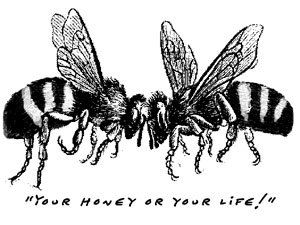
The bee population in these parts has been acting weird since last week, and the time finally came to determine whether there was really something wrong. However, if I knew how to formulate such a conclusion myself, I would not have needed so much determination. So I posted this on our beekeeping club's online bulletin board for beginners:
From: phang@tonitoni.org
Date: Thu Aug 25, 2005 7:24 pm
Subject: Fighting Bees in Late Summer
Over the past week, there has been an increase in bee-to-bee combat: does anyone know what the cause could be, whether it is significant, and what I should do?
Probably the main questions are:- Is this a heat-related or seasonal behavior?
- Is this a human management problem (like robbing)?
- Is some intervention advisable?
I noticed a bit of fighting after working the bees last week. I had moved two frames of brood from my strong colony to my weak one, and after found a few dozen dead bees. It seemed possible that I had transferred too many bees with the brood or had not let the frames stand long enough before moving them.
But today, a week later, after cleaning up and feeding more sugar water, another (but smaller) number of dead bees appeared. I saw two fights, though they appeared to be drones getting beat up (the other dead bees were workers). Also, the fighting seemed concentrated around the stronger of the two colonies, not the one that received brood.
After such nice days, lovely cooler weather, and a plentiful sugar water supply, it seemed odd for something that seems stress-related to appear. Your thoughts welcome! I also posted the query to beesource.com. And got the same answer. Which was:
- I screwed up by allowing any bees at all to transfer with the new capped brood: they might put up with it in Spring, but not in late Summer; and
- My feeding, by being at the wrong time of day (not early AM or evening) and with too many openings in the weak hive, had triggered some robbing.
So like a good little girl, I did a couple of things: on Friday evening I closed the second entrance to Wilde, and I cast baleful looks at Twain. Ta-Dah.
Big whoop.
On Sunday (8/28), I went up around 11 AM (notice how I still had not learned my lesson?) and there was a full scale robbery on: hundreds of bees in a cloud at the entrance to Wilde, a brawl, carnage, awful, and MEAN.
The previous excuse for a response had not been enough. So I quickly put in an entrance reducer on the only remaining opening in the weaker colony, and fed the heck out of Twain (home of the bloody minded bees). AFTER running downstairs in desperation, logging into my computer to get information and advice, I learned that Italian honeybees are well known for this behavior. Apparently everyone knows. I must have been late for class that day...
So today I worked out how to make an anti-robbing screen, another item which – if I had been paying attention – could have prevented the whole apiary cataclysm in the first place. You can see the details in the "Thwarted" photo page at right.
Finally, in order to churn some good out of this, I wrote a little article on this comedy because our club newsletter requested submissions. If there are more misconceptions, I hope they edit them out. The unexpurgated version is pasted below. Sigh.
The Thieves of AugustGuilt, blame, and recrimination are such ugly experiences, yet they are the most natural things in the world at the scene of a crime. I'm talking about theft, assault, and murder, all taking place between neighbors and sisters. What is the world coming to? Late summer, my friends.
Yesterday morning my apiary became a bit of a killing field. By 11 AM, it was all abuzz with a full scale robbing attempt by the strong upon the weak. My gangbuster Italian colony was attacking my poor struggling Carniolans, and what was meant to be a peaceful Sunday morning bee feeding in front of curious visiting family members turned into another round of beginner scrambling.
Since hindsight is 20-20, problems in this picture are already becoming clear. Who demonstrates beekeeping in August? Why had my bees been aggressive even after the temperatures cooled? In times of nectar dearth, what was I doing opening hives or feeding in the middle of the day? Why didn't I know that Italian honeybees are notorious robbers?
And it gets worse. There had been other warnings. But here might be the main point: for the beginner, so much of beekeeping is to know what you are seeing. Let us not overlook a more subtle point: you also need to know what you should not be seeing. This is very hard to teach in a short course. This is very hard to teach without benefit of a late summer dearth of nectar. But sad experience is a great instructor. But maybe I can tell you what happened at this particular crime scene, and you can undertake a more successful neighborhood watch.
The perpetrators were first spotted fighting with unidentified bees shortly after the beekeeper messed up the process of moving two frames of brood between colonies in early-mid August. This seemed like a turf war, one gang eliminating some interlopers from their territory (something the beekeeper should have done ahead of time). Except that was only part of it.
There was also suspicious activity for some time at the back entrance of the smaller colony, a group that had never been all that keen on their sugar water before, but had taken to importing suspicious quantities. Law enforcement attempted to identify the suspicious characters frequenting the back door to the establishment, but found she was clueless.
As often happens in crime-ridden neighborhoods, gang members with crummy attitudes starting congregating in additional locations, annoying law-abiding citizens, including neighbors. Perhaps you could tell me what business honeybees had hovering over the floorboards of the back porch, occasionally bumping the sliding door and the exiting dog. A person on the street said, "Why are all these bees suddenly hanging out in my yard?" I got stung watering plants in the yard, and – for the first time – it was one of mine.
Finally, the Mid-August Massacre might have tipped off law enforcement. Dozens of dead bees carpeting the apiary between the colonies, more fights in plain sight. So I called in backup.
In the midst of this sorry saga, let us give thanks for the goodwill of experienced beekeepers, including those who answer queries on the MCBA bulletin boards and the good people at BeeSource. Because they were right that I was beginning to see robbing, but even being told did not help me to go straight.
Closing the back door to the weakened colony was not enough: common sense, not that I had any. That same afternoon, both colonies got more sugar water, since they are being raised from packages. This was the gasoline on the simmering coals of gang war.
I don't know how long the robbing went on, though there were only a couple of days between visits this time. There is an entrance reducer in place now, and I am going to make this groovy anti-robbing screen I found on bee source. I'm thinking I may not have a Carniolan colony anymore, but cluelessness can also mean pigheadedness, so I am still going to try to bring them along.
If any of this contains advice to wise, it would be:
- The bees of August are not the easy going girls of Spring, and you cannot treat them the same;
- Changes in bee behavior mean you are seeing basic shifts in the Bee Operating Protocol, that predictable pattern we need to manage them. Knowing when something is different is your only hope of bringing them back to that safe sameness we count on;
- Those particularities between bee families – like Italian bees rob and Carniolans tend to build population a little late for our area – can suddenly get really important, even to a beginner who did not pay enough attention in class; and
- An autumn Goldenrod flow would really help right now.
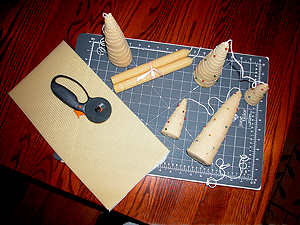 Beekeeper meetings (like bee blogs) get short on material in the winter, so our last formal agenda focused on "how to roll beeswax candles."
Beekeeper meetings (like bee blogs) get short on material in the winter, so our last formal agenda focused on "how to roll beeswax candles." 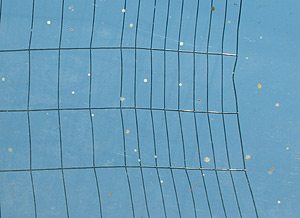 For the first time this month, temperatures on the roof rose to about 50 degrees F, and the girls took flight. It was a day of much work for them, I think, as well as a bit of a release and relief.
For the first time this month, temperatures on the roof rose to about 50 degrees F, and the girls took flight. It was a day of much work for them, I think, as well as a bit of a release and relief.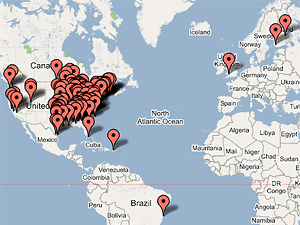
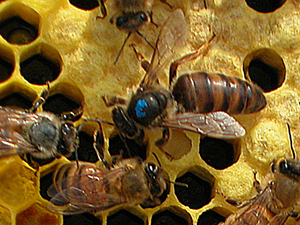 The bee at top is Elizabeth, the Queen of the Wilde colony. That sporty blue mark came from the beekeeper who bred her. If you look at her, she resembles the bees' cousin the wasp more than her workers do. Notice that her broad shoulders have no fuzz, and that her butt is way long and tapered. I think she is pretty. This picture was taken in late May.
The bee at top is Elizabeth, the Queen of the Wilde colony. That sporty blue mark came from the beekeeper who bred her. If you look at her, she resembles the bees' cousin the wasp more than her workers do. Notice that her broad shoulders have no fuzz, and that her butt is way long and tapered. I think she is pretty. This picture was taken in late May.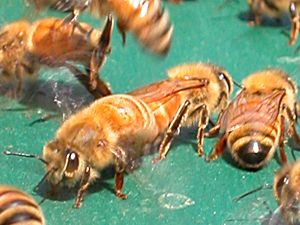 Now, here at the front left is a young worker bee, currently a house bee. After they emerge, bees spend about the first three weeks of their life doing tasks inside the hive. In this picture, it's a really hot day and the girls are fanning up a storm to try to cool the hot insides of the hive boxes. Take a look at her shoulders, where the wings attach. She is all golden and fuzzy! Most of the bees I see when opening the hives are like this: young and occupied with tasks like nursing young, drawing out honeycomb, and putting away honey stores. The girls were fanning so hard because it is still late May, and the BeeCool hive ventilators have not arrived. I think she looks like she is saying "Hurry up already with the AC!"
Now, here at the front left is a young worker bee, currently a house bee. After they emerge, bees spend about the first three weeks of their life doing tasks inside the hive. In this picture, it's a really hot day and the girls are fanning up a storm to try to cool the hot insides of the hive boxes. Take a look at her shoulders, where the wings attach. She is all golden and fuzzy! Most of the bees I see when opening the hives are like this: young and occupied with tasks like nursing young, drawing out honeycomb, and putting away honey stores. The girls were fanning so hard because it is still late May, and the BeeCool hive ventilators have not arrived. I think she looks like she is saying "Hurry up already with the AC!"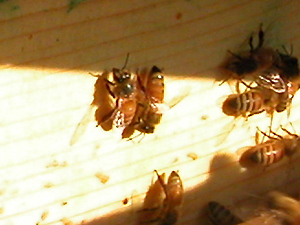 It's not easy to get a picture of an old bee: they tend to be out in the field during the day when I make my visits, and they try to die outside of the hive so no other bee has the extra work of pushing them out the front door when they pass. The bee furthest to the left has probably lived most of her life by now. Look at her shoulders: the fur has been worn off of her back, probably scraped away little by little by all of her trips in and out of the narrow hive entrance.
It's not easy to get a picture of an old bee: they tend to be out in the field during the day when I make my visits, and they try to die outside of the hive so no other bee has the extra work of pushing them out the front door when they pass. The bee furthest to the left has probably lived most of her life by now. Look at her shoulders: the fur has been worn off of her back, probably scraped away little by little by all of her trips in and out of the narrow hive entrance. 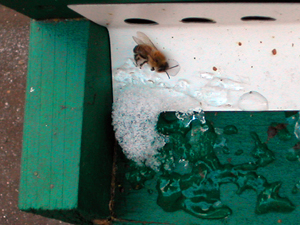 Winter is well and truly here: our first snow came last night, leaving a couple of inches and some ice. I went up to peer at the bees, not wanting to disturb them enough to cause a guard bee to detach from the inside cluster. Giving me a piece of her mind could cost her the rest of her life when the temperature is low!
Winter is well and truly here: our first snow came last night, leaving a couple of inches and some ice. I went up to peer at the bees, not wanting to disturb them enough to cause a guard bee to detach from the inside cluster. Giving me a piece of her mind could cost her the rest of her life when the temperature is low!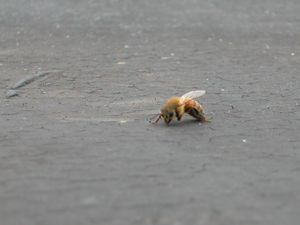 My roof is a place of creeping bees, with dozens and dozens of them wandering about yesterday, and only a few trundling around today. The weather got cold last week, and yesterday the temperature got warm (up to 60 degrees F), so you might expect to see the girls out and aloft, but it's not clear to me what all this ambling means.
My roof is a place of creeping bees, with dozens and dozens of them wandering about yesterday, and only a few trundling around today. The weather got cold last week, and yesterday the temperature got warm (up to 60 degrees F), so you might expect to see the girls out and aloft, but it's not clear to me what all this ambling means.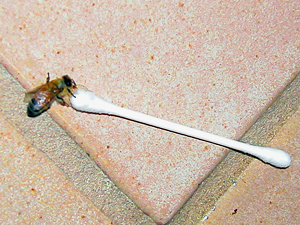 Finally, to close the day, one of the creeping bees showed up in the bathroom. It's become easy to tell the buzz of a lost girl from the whine of a fly. It was far too late to put her outside, so I gave her a meal of honey-on-a-stick and put her in a box with a damp kleenex for the night. She was still alive in the morning, and I set the whole box outside. In an hour, she was gone: whether to home or the sunset, I do not know.
Finally, to close the day, one of the creeping bees showed up in the bathroom. It's become easy to tell the buzz of a lost girl from the whine of a fly. It was far too late to put her outside, so I gave her a meal of honey-on-a-stick and put her in a box with a damp kleenex for the night. She was still alive in the morning, and I set the whole box outside. In an hour, she was gone: whether to home or the sunset, I do not know.
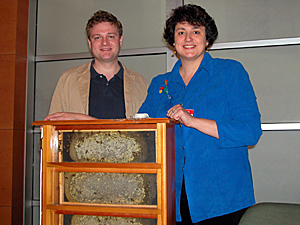 The cold season has arrived, with a thump, and most of the bee-oriented concerns revolve around temperatures and wind speed, and repeated reassurances (from self and husband) that honeybees have been through this before. For millenia. In even tougher locations. With less food. (Chant the former as often as necessary to reassert psychic well-being...)
The cold season has arrived, with a thump, and most of the bee-oriented concerns revolve around temperatures and wind speed, and repeated reassurances (from self and husband) that honeybees have been through this before. For millenia. In even tougher locations. With less food. (Chant the former as often as necessary to reassert psychic well-being...)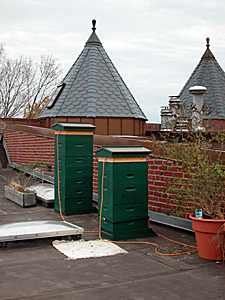 Monday was the day to remove the last packets of spent medication, take a sounding of how much honey was stored up for the winter, and step back for the quieter days of winter. The past few months have left me filled with wonder about the bees, as well as fuddled by periods of bad temper, knocked out by the weight of hefting the honey they have stored, confused about the what and when of medications, and gratified by the help and insight of my fellow beekeepers. Who knew I would be hanging out with a veil after all!
Monday was the day to remove the last packets of spent medication, take a sounding of how much honey was stored up for the winter, and step back for the quieter days of winter. The past few months have left me filled with wonder about the bees, as well as fuddled by periods of bad temper, knocked out by the weight of hefting the honey they have stored, confused about the what and when of medications, and gratified by the help and insight of my fellow beekeepers. Who knew I would be hanging out with a veil after all!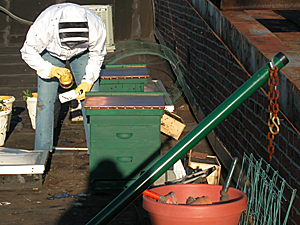
 Here's the top of Twain's brood area: you can see those bumptious bees have totally wolfed down the grease patty that was in the middle. The light brown area in the center is the humble remains of the parchment on which it was sitting. The actual piece of paper is edged with little bee bites. I have already pulled the med packets out here, and thankfully there were only the right number. Putting things back together, the bees seem dazed, though. I think the low temps slow down their bee CPUs, and I have to be careful not to step on anyone.
Here's the top of Twain's brood area: you can see those bumptious bees have totally wolfed down the grease patty that was in the middle. The light brown area in the center is the humble remains of the parchment on which it was sitting. The actual piece of paper is edged with little bee bites. I have already pulled the med packets out here, and thankfully there were only the right number. Putting things back together, the bees seem dazed, though. I think the low temps slow down their bee CPUs, and I have to be careful not to step on anyone. The voyage into Wilde came next. There is plenty of activity at the front door, maybe more than Twain, but these girls did not do much with their grease patty. I took away the med packets, pushed the patty to the side (broke it, though), and closed her up. A carpenter bee was hanging around Wilde, but it did not look like there was robbing. The top honey super seemed light, so I will give these girls some more syrup sometime (and hope they take it).
The voyage into Wilde came next. There is plenty of activity at the front door, maybe more than Twain, but these girls did not do much with their grease patty. I took away the med packets, pushed the patty to the side (broke it, though), and closed her up. A carpenter bee was hanging around Wilde, but it did not look like there was robbing. The top honey super seemed light, so I will give these girls some more syrup sometime (and hope they take it).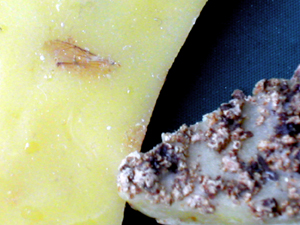 The three main products of the hive are (in approximate order) pollination, honey, and beeswax. The first is a service that my bees perform mostly for trees, wildflowers, and nearby urban gardeners, though the wild birds are probably pretty happy about the extra berries and fruits in the neighborhood. This year, the honey crop boils down to the pair of one-pint mason jars I entered in the fair, though it seems that the girls produced enough that we could have extracted more after all. Beeswax, however, still harbors some mysteries for me.
The three main products of the hive are (in approximate order) pollination, honey, and beeswax. The first is a service that my bees perform mostly for trees, wildflowers, and nearby urban gardeners, though the wild birds are probably pretty happy about the extra berries and fruits in the neighborhood. This year, the honey crop boils down to the pair of one-pint mason jars I entered in the fair, though it seems that the girls produced enough that we could have extracted more after all. Beeswax, however, still harbors some mysteries for me.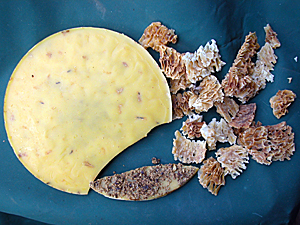 It turns out that most clued-in beekeepers have something called a solar wax melter into which they dump the beeswax bits and parings over the year, and the sun turns them into a lovely little pool of wax. Upon asking where one gets such a thing, most of the beekeepers in my club start going on about table saws and routers and all those things that I don't have in my basement, but perhaps I can buy one next year...preassembled like all my other bee gear. The second picture gives you an idea of how beeswax scrapings compare to melted wax. The variance in color is ultra cool, to my mind. The bees have dirty little feet from running around in the same world in which we live, and the wax varies in color depending on whether it is from a comparative bee highway, or maybe a newly paved suburban cul de sac.
It turns out that most clued-in beekeepers have something called a solar wax melter into which they dump the beeswax bits and parings over the year, and the sun turns them into a lovely little pool of wax. Upon asking where one gets such a thing, most of the beekeepers in my club start going on about table saws and routers and all those things that I don't have in my basement, but perhaps I can buy one next year...preassembled like all my other bee gear. The second picture gives you an idea of how beeswax scrapings compare to melted wax. The variance in color is ultra cool, to my mind. The bees have dirty little feet from running around in the same world in which we live, and the wax varies in color depending on whether it is from a comparative bee highway, or maybe a newly paved suburban cul de sac. 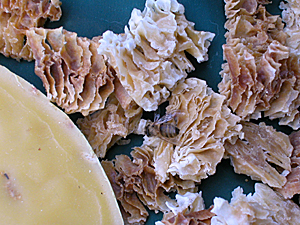 Even after you melt the wax, however, there is this small problem of bee bits. The top photo shows a beeswing preserved in wax. I opted to melt a handful of beeswax in water using a double boiler, and got a lovely yellow disk with the odd bee leg or wing floating near the top, and some undefined scunge on the bottom (I broke a bit and turned it over so you could see).
Even after you melt the wax, however, there is this small problem of bee bits. The top photo shows a beeswing preserved in wax. I opted to melt a handful of beeswax in water using a double boiler, and got a lovely yellow disk with the odd bee leg or wing floating near the top, and some undefined scunge on the bottom (I broke a bit and turned it over so you could see). 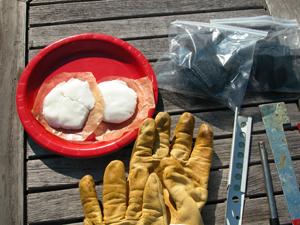 Today was the appointed time for placing the last round of autumn medications on the bee colonies. Just to recap, I chose to use medications for tracheal mites, nosema, and varroa mites, and the remedy I chose for the latter required that I open up the hives three times, at intervals of a little more than a week, and place wafers impregnated with essential oils right over where the bees are hatched.
Today was the appointed time for placing the last round of autumn medications on the bee colonies. Just to recap, I chose to use medications for tracheal mites, nosema, and varroa mites, and the remedy I chose for the latter required that I open up the hives three times, at intervals of a little more than a week, and place wafers impregnated with essential oils right over where the bees are hatched.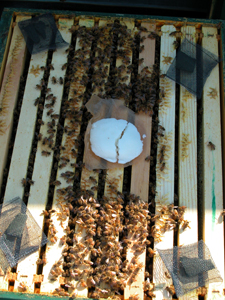 Because I could not resist, I pulled a frame from the deep honey super inside Twain, and they had emptied one side of the first frame. That's 4.5 pounds of honey, an amount that they can (more than) replace if they take another feeding of syrup from me in 12 days — the time I am scheduled to return and remove all my packets, and begin the long quiet winter time.
Because I could not resist, I pulled a frame from the deep honey super inside Twain, and they had emptied one side of the first frame. That's 4.5 pounds of honey, an amount that they can (more than) replace if they take another feeding of syrup from me in 12 days — the time I am scheduled to return and remove all my packets, and begin the long quiet winter time.
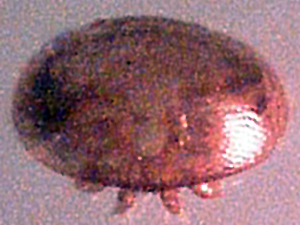 You non-beekeepers out there probably get bored out of your minds by my constant discussions of the ways of mites and men, but perhaps this picture might make the point. The nightmarish bug above, which looks like a hairy-legged lentil at 60 times magnification, is actually a varroa mite — a critter that lives to for two purposes: to suck the life out of developing bees, and then make more of itself. It's not much more than a grasping mouth and reproductive system with a poorly thought out transportation arrangement.
You non-beekeepers out there probably get bored out of your minds by my constant discussions of the ways of mites and men, but perhaps this picture might make the point. The nightmarish bug above, which looks like a hairy-legged lentil at 60 times magnification, is actually a varroa mite — a critter that lives to for two purposes: to suck the life out of developing bees, and then make more of itself. It's not much more than a grasping mouth and reproductive system with a poorly thought out transportation arrangement.  Beekeepers often refer to September 1st as the "Beekeeper New Year," a time to start putting the bees to bed for this year, and to make preparations for next. These tasks include checking to see whether the hives seem to have stored adequate honey for the winter – around here that means at least 60, and as much as 90 pounds – placing menthol to drive away tracheal mites, deciding upon and executing a treatment for varroa mites (those are the ones you might have heard about on the news), and pouring in sugar syrup that contains a medication for Nosema, a digestive tract disease that sort of gnaws away at the health and productivity of a colony.
Beekeepers often refer to September 1st as the "Beekeeper New Year," a time to start putting the bees to bed for this year, and to make preparations for next. These tasks include checking to see whether the hives seem to have stored adequate honey for the winter – around here that means at least 60, and as much as 90 pounds – placing menthol to drive away tracheal mites, deciding upon and executing a treatment for varroa mites (those are the ones you might have heard about on the news), and pouring in sugar syrup that contains a medication for Nosema, a digestive tract disease that sort of gnaws away at the health and productivity of a colony.  The menthol all went in in mid-September, just before I found out that it was potentially OK to skip it. I chose ApiLifeVAR as my varroa treatment, mostly because it is not an antibiotic per se but a concentration of essential oils (thyme, eucalyptus, menthol). It's organic and non-polluting. The varroa treatment comes in wafers that must not touch bare skin, and which needed to be enclosed in little screen envelopes to keep the bees out of direct contact, too. So I had a bit of homework to do before placing it. And putting it in the hives would be a chore in itself: you can see from the green areas in the illustrations where the wafres need to go, directly above the brood nest. The first, and smaller, colony is Wilde, my girls who have struggled along this year. The second illustration is much-larger Twain, rampantly healthy and tending to rapacious behavior.
The menthol all went in in mid-September, just before I found out that it was potentially OK to skip it. I chose ApiLifeVAR as my varroa treatment, mostly because it is not an antibiotic per se but a concentration of essential oils (thyme, eucalyptus, menthol). It's organic and non-polluting. The varroa treatment comes in wafers that must not touch bare skin, and which needed to be enclosed in little screen envelopes to keep the bees out of direct contact, too. So I had a bit of homework to do before placing it. And putting it in the hives would be a chore in itself: you can see from the green areas in the illustrations where the wafres need to go, directly above the brood nest. The first, and smaller, colony is Wilde, my girls who have struggled along this year. The second illustration is much-larger Twain, rampantly healthy and tending to rapacious behavior.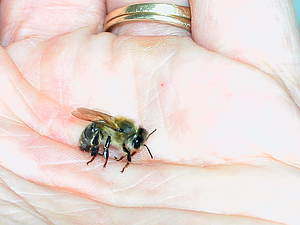 This blog has gone post-less this weekend, in part because the beekeeper has been a bit listless, and in part because – right after Rocky's departure – it proceeded to rain, and rain, and rain.
This blog has gone post-less this weekend, in part because the beekeeper has been a bit listless, and in part because – right after Rocky's departure – it proceeded to rain, and rain, and rain. Romantic notions about life and death would be, I thought, the first things to fall under siege with this beekeeping thing. I was not conceding the outcome of this hard-edged enlightenment, but admitting the obvious: I live in the city. I live in a world where most of the creatures are either imperilled wild things or treasured pets. Being a beekeeper is like playing god, not like playing parent to a pet. I have to choose who dies sometimes. I hate this. I do it. It's not routine, and I don't feel good about it. But it's not keeping me up at night, and I feel like there is a lesson in it. The upshot is not about being hard-hearted, it's about the unconceivably numerous ocean of life, the sheer numbers of living things coursing around us, and how impossible it is for any one living thing to see the whole and understand what it happening to it. In one case, an early death, in another, an extended life. No reason given.
Romantic notions about life and death would be, I thought, the first things to fall under siege with this beekeeping thing. I was not conceding the outcome of this hard-edged enlightenment, but admitting the obvious: I live in the city. I live in a world where most of the creatures are either imperilled wild things or treasured pets. Being a beekeeper is like playing god, not like playing parent to a pet. I have to choose who dies sometimes. I hate this. I do it. It's not routine, and I don't feel good about it. But it's not keeping me up at night, and I feel like there is a lesson in it. The upshot is not about being hard-hearted, it's about the unconceivably numerous ocean of life, the sheer numbers of living things coursing around us, and how impossible it is for any one living thing to see the whole and understand what it happening to it. In one case, an early death, in another, an extended life. No reason given.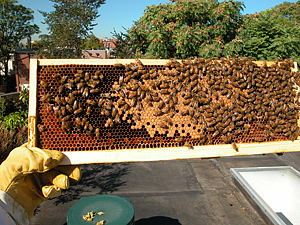 Both hives have brood, bees to be. I am so grateful, relieved, and embarrassed to find myself in such a weirdly opposite place to my last post. I also need a shower.
Both hives have brood, bees to be. I am so grateful, relieved, and embarrassed to find myself in such a weirdly opposite place to my last post. I also need a shower.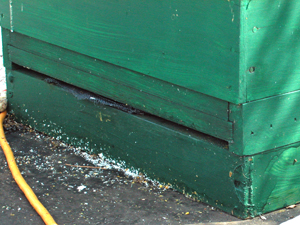 Today, I cheated.
Today, I cheated. 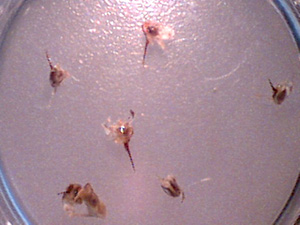 When working the bees, many more of them light on me and yell at me and bang at my veil than actually sting me, and my hope had been that all those girls trying fervently to land one through the veil and the jacket were doomed to fail... and therefore to continue living.
When working the bees, many more of them light on me and yell at me and bang at my veil than actually sting me, and my hope had been that all those girls trying fervently to land one through the veil and the jacket were doomed to fail... and therefore to continue living. Sometimes working the bees is like playing god, and sometimes it's more like playing the heavy in the Divine Comedy. Today was such a day.
Sometimes working the bees is like playing god, and sometimes it's more like playing the heavy in the Divine Comedy. Today was such a day.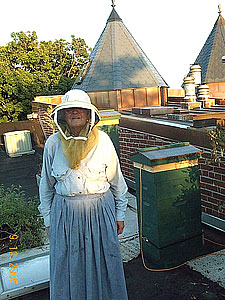 Yesterday, my apiary hosted it's first-ever bee tourist: my friend Elizabeth's cousin Todd from Berkeley.
Yesterday, my apiary hosted it's first-ever bee tourist: my friend Elizabeth's cousin Todd from Berkeley.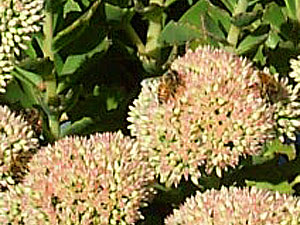 The photo this time shows a pot of stonecrop on my roof, a feasting site for bees of all persuasions over the past week. It's included here for two reasons: finally there is something out there for the girls to eat, and it turns out to be something I can happily plant en masse on a hot city roof. Where coneflowers and buddleia have failed, bring on the succulents!
The photo this time shows a pot of stonecrop on my roof, a feasting site for bees of all persuasions over the past week. It's included here for two reasons: finally there is something out there for the girls to eat, and it turns out to be something I can happily plant en masse on a hot city roof. Where coneflowers and buddleia have failed, bring on the succulents! 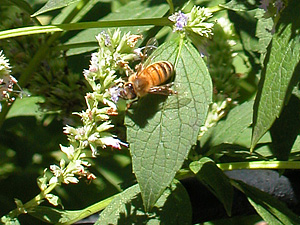 A week out, it appears that the robbing crisis is over, at least unless some other incident – syrup spillage, opening the colonies, spite – triggers another bout. The gentleman who told me about setting up robbing screens said that his bees regained their sweet disposition within a few days of the reinstitution of the rule of law.
A week out, it appears that the robbing crisis is over, at least unless some other incident – syrup spillage, opening the colonies, spite – triggers another bout. The gentleman who told me about setting up robbing screens said that his bees regained their sweet disposition within a few days of the reinstitution of the rule of law. The bee population in these parts has been acting weird since last week, and the time finally came to determine whether there was really something wrong. However, if I knew how to formulate such a conclusion myself, I would not have needed so much determination. So I posted this on our beekeeping club's online bulletin board for beginners:
The bee population in these parts has been acting weird since last week, and the time finally came to determine whether there was really something wrong. However, if I knew how to formulate such a conclusion myself, I would not have needed so much determination. So I posted this on our beekeeping club's online bulletin board for beginners: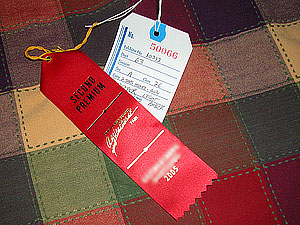 As you may have read here, first year beekeepers (like me) are not supposed to expect or extract a honey harvest. Our worker bees have got their papillae full just rearing new co-workers, building a new colony, and setting aside adequate stores for the winter.
As you may have read here, first year beekeepers (like me) are not supposed to expect or extract a honey harvest. Our worker bees have got their papillae full just rearing new co-workers, building a new colony, and setting aside adequate stores for the winter.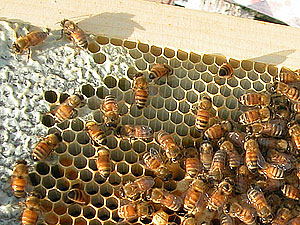 After a couple of weeks away – fourteen days of baking bees – I really wanted to check in, especially on Wilde, to see if the colonies were standing up to the high temps and low nectar flow of late summer in this area. They are clearly in a totally crappy mood. Guard bees are taking shots at me when I am on the other side of the roof, watering plants: there is no chance I can manage them bare handed right now.
After a couple of weeks away – fourteen days of baking bees – I really wanted to check in, especially on Wilde, to see if the colonies were standing up to the high temps and low nectar flow of late summer in this area. They are clearly in a totally crappy mood. Guard bees are taking shots at me when I am on the other side of the roof, watering plants: there is no chance I can manage them bare handed right now.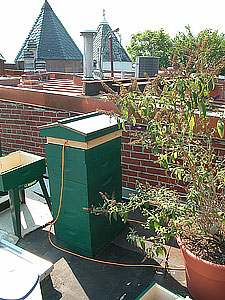 We got home on the oh-god-thirty flight from Boston, and as soon as I could get the (seemingly surprised) housesitter on her way, I mixed up some sugar water, gulped a few times and went to check on the girls.
We got home on the oh-god-thirty flight from Boston, and as soon as I could get the (seemingly surprised) housesitter on her way, I mixed up some sugar water, gulped a few times and went to check on the girls.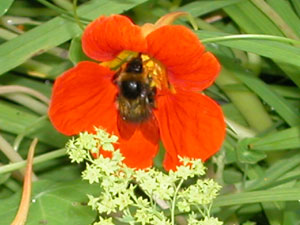 For the past couple of weeks, we have been on vacation in Europe. Highlights have included a visit with a real-life British beekeeper, purchasing honey from bees who live on the roof of the Paris Opera, and driving my family crazy with constant bee-spotting. This bee was working outside a small church in Warminster, Wiltshire.
For the past couple of weeks, we have been on vacation in Europe. Highlights have included a visit with a real-life British beekeeper, purchasing honey from bees who live on the roof of the Paris Opera, and driving my family crazy with constant bee-spotting. This bee was working outside a small church in Warminster, Wiltshire.